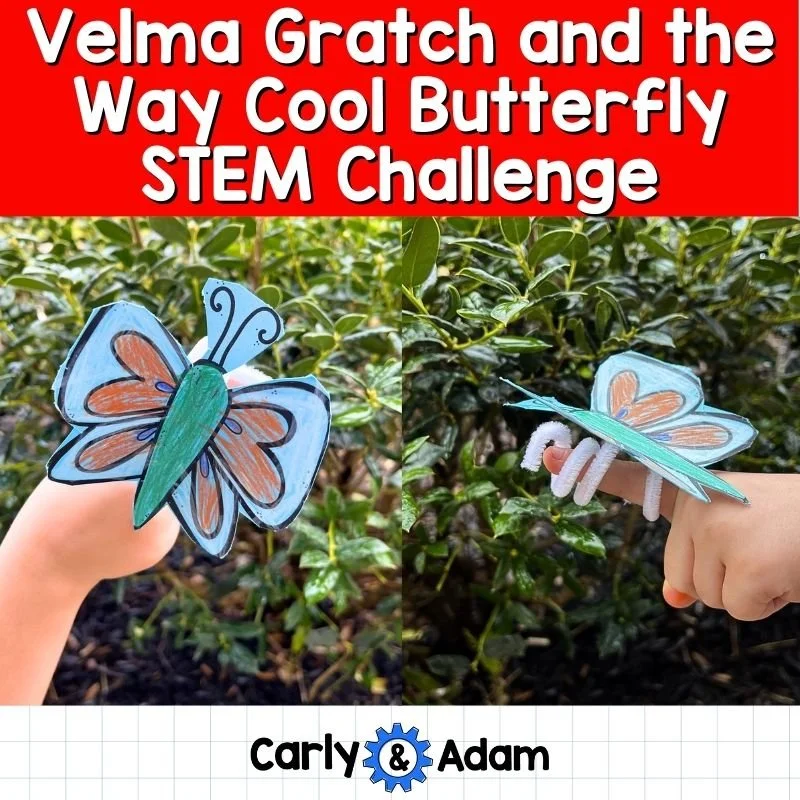Butterfly Life Cycle STEM Activity
Butterflies are fascinating creatures that captivate the hearts and minds of children and adults alike.
Their life cycle is a tale of transformation and resilience, offering a unique opportunity to teach elementary students about the wonders of nature.
This blog post will provide elementary teachers with a comprehensive guide to teaching the butterfly life cycle using read-alouds and incorporating the story of Velma Gratch, as well as incorporating additional resources to enhance your lessons.
1. Introduce the Life Cycle with Velma Gratch.
Velma Gratch is the protagonist of the delightful children's book, "Velma Gratch and the Way Cool Butterfly" by Alan Madison.
Velma Gratch Read Aloud STEM Challenge by Carly and Adam
This story offers a fantastic starting point to introduce the butterfly life cycle. Read the book aloud to your students and discuss how Velma's experiences relate to the four stages of the butterfly life cycle: egg, larva (caterpillar), pupa (chrysalis), and adult (butterfly).
2. Incorporate Art and Hands-On STEM Activities.
Use art projects and hands-on activities to solidify the students' understanding of the life cycle.
Velma Gratch Read Aloud STEM Challenge by Carly and Adam
Materials:
butterfly template (included)
scissors
tape
color sticks, crayons, or markers
pipe cleaners
clothespin (one per student or group)
Have students follow the engineering design process to construct their own symmetrical butterfly. They can attach it to their finger and have it fly around outside or in the classroom.
3. Integrate Symmetry into your lesson.
Butterflies are not only fascinating creatures due to their life cycle, but they also offer a fantastic opportunity to teach the concept of symmetry to elementary students.
Velma Gratch Read Aloud STEM Challenge by Carly and Adam
Encourage students to explore different symmetrical patterns and colors while creating their unique butterfly designs.
4. Include Engaging Visuals.
We are visual learners. It’s important to have posters of butterflies and their life cycle in the classroom for students to reference.
Velma Gratch Read Aloud STEM Challenge by Carly and Adam
Include the four stages of the butterfly life cycle: egg, larva (caterpillar), pupa (chrysalis), and adult (butterfly).
5. Collaborate with Other Teachers.
Consider teaming up with other teachers in your school to create a cross-curricular learning experience.
Velma Gratch Read Aloud STEM Challenge by Carly and Adam
For example, collaborate with the art teacher to create butterfly-inspired artwork, or work with the physical education teacher to create a butterfly-themed obstacle course that represents the life cycle stages.
Students could fly their finger butterflies all through the course.
This approach can make learning more engaging and memorable for students.
Velma Gratch Read Aloud STEM Challenge by Carly and Adam
Teaching the butterfly life cycle offers a fantastic opportunity to inspire curiosity and wonder in elementary students.
Using engaging read-alouds, such as Velma Gratch, and incorporating additional resources like the Butterfly Life Cycle STEM Activities and Challenges, can create a well-rounded learning experience that captures the magic of nature's transformations.
Don't forget to collaborate with fellow teachers and enjoy the journey as your students discover the incredible world of butterflies.
The STEM Teachers Club Membership is a fantastic place to improve your lessons and teaching strategies for integrating STEM in your classroom.
Have more questions or need additional resources?
You can get all 250+ STEM Challenges by Carly and Adam as part of the STEM Teachers Club Membership. Save $5 on your first month using coupon Code: CarlyAndAdamBlog.
We hope you have found this blog post helpful. To stay connected with Carly and Adam's teaching tips and classroom freebies be sure to follow us on Facebook, Pinterest, Teachers Pay Teachers, and subscribe to our blog!






